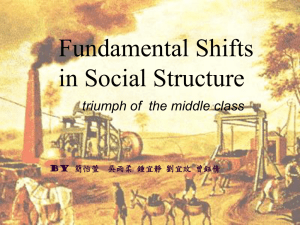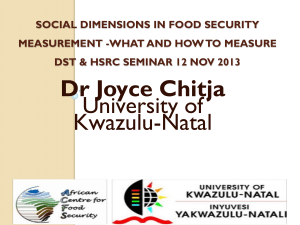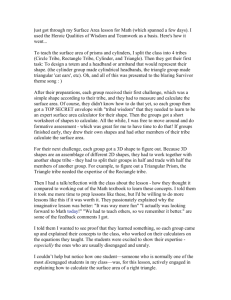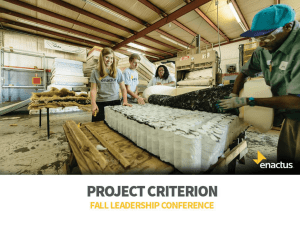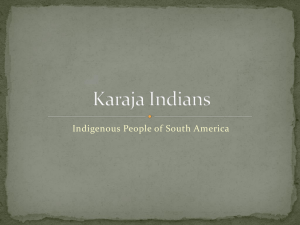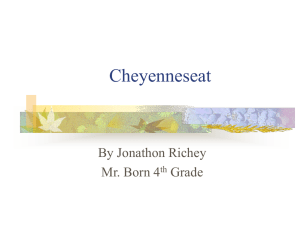SOCIO-ECOLOGICAL CHANGE AND LIVELIHOOD ADJUSMENT: A
advertisement
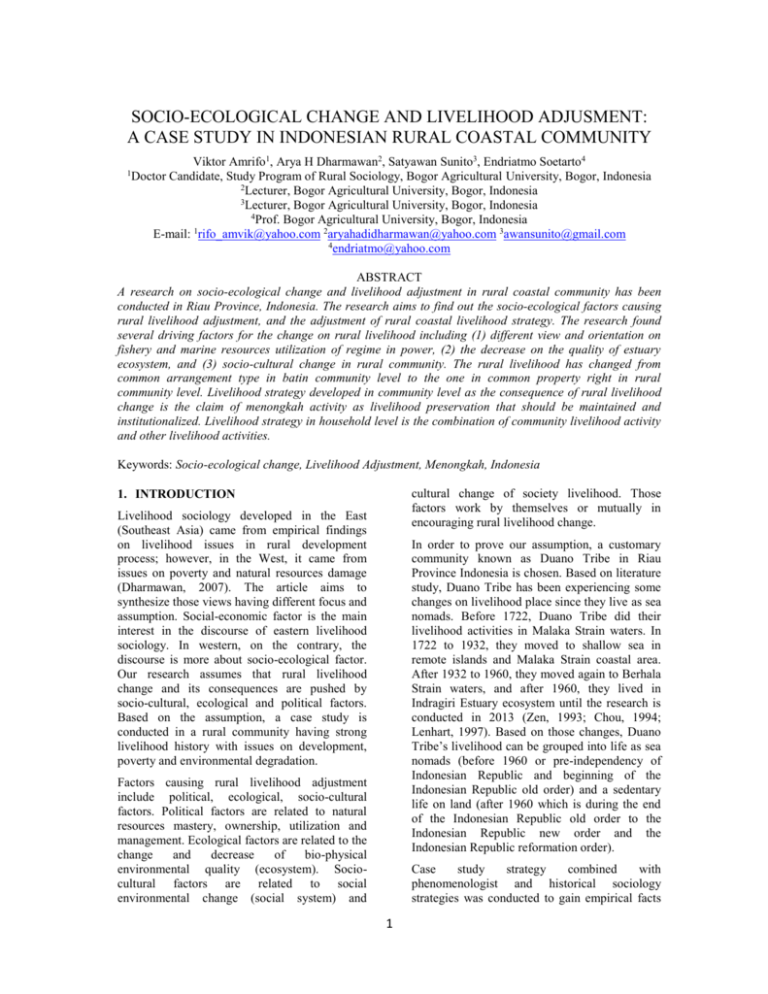
SOCIO-ECOLOGICAL CHANGE AND LIVELIHOOD ADJUSMENT: A CASE STUDY IN INDONESIAN RURAL COASTAL COMMUNITY 1 Viktor Amrifo1, Arya H Dharmawan2, Satyawan Sunito3, Endriatmo Soetarto4 Doctor Candidate, Study Program of Rural Sociology, Bogor Agricultural University, Bogor, Indonesia 2 Lecturer, Bogor Agricultural University, Bogor, Indonesia 3 Lecturer, Bogor Agricultural University, Bogor, Indonesia 4 Prof. Bogor Agricultural University, Bogor, Indonesia 1 E-mail: rifo_amvik@yahoo.com 2aryahadidharmawan@yahoo.com 3awansunito@gmail.com 4 endriatmo@yahoo.com ABSTRACT A research on socio-ecological change and livelihood adjustment in rural coastal community has been conducted in Riau Province, Indonesia. The research aims to find out the socio-ecological factors causing rural livelihood adjustment, and the adjustment of rural coastal livelihood strategy. The research found several driving factors for the change on rural livelihood including (1) different view and orientation on fishery and marine resources utilization of regime in power, (2) the decrease on the quality of estuary ecosystem, and (3) socio-cultural change in rural community. The rural livelihood has changed from common arrangement type in batin community level to the one in common property right in rural community level. Livelihood strategy developed in community level as the consequence of rural livelihood change is the claim of menongkah activity as livelihood preservation that should be maintained and institutionalized. Livelihood strategy in household level is the combination of community livelihood activity and other livelihood activities. Keywords: Socio-ecological change, Livelihood Adjustment, Menongkah, Indonesia cultural change of society livelihood. Those factors work by themselves or mutually in encouraging rural livelihood change. 1. INTRODUCTION Livelihood sociology developed in the East (Southeast Asia) came from empirical findings on livelihood issues in rural development process; however, in the West, it came from issues on poverty and natural resources damage (Dharmawan, 2007). The article aims to synthesize those views having different focus and assumption. Social-economic factor is the main interest in the discourse of eastern livelihood sociology. In western, on the contrary, the discourse is more about socio-ecological factor. Our research assumes that rural livelihood change and its consequences are pushed by socio-cultural, ecological and political factors. Based on the assumption, a case study is conducted in a rural community having strong livelihood history with issues on development, poverty and environmental degradation. In order to prove our assumption, a customary community known as Duano Tribe in Riau Province Indonesia is chosen. Based on literature study, Duano Tribe has been experiencing some changes on livelihood place since they live as sea nomads. Before 1722, Duano Tribe did their livelihood activities in Malaka Strain waters. In 1722 to 1932, they moved to shallow sea in remote islands and Malaka Strain coastal area. After 1932 to 1960, they moved again to Berhala Strain waters, and after 1960, they lived in Indragiri Estuary ecosystem until the research is conducted in 2013 (Zen, 1993; Chou, 1994; Lenhart, 1997). Based on those changes, Duano Tribe’s livelihood can be grouped into life as sea nomads (before 1960 or pre-independency of Indonesian Republic and beginning of the Indonesian Republic old order) and a sedentary life on land (after 1960 which is during the end of the Indonesian Republic old order to the Indonesian Republic new order and the Indonesian Republic reformation order). Factors causing rural livelihood adjustment include political, ecological, socio-cultural factors. Political factors are related to natural resources mastery, ownership, utilization and management. Ecological factors are related to the change and decrease of bio-physical environmental quality (ecosystem). Sociocultural factors are related to social environmental change (social system) and Case study strategy combined with phenomenologist and historical sociology strategies was conducted to gain empirical facts 1 giving evidence for the determined basic assumptions and research purpose. The research tries to answer several following purposes, including factors causing the adjustment on rural livelihood, type of livelihood before and after the change and the influence of socio-cultural and ecological politics of rural change on the livelihood strategy of Duano Tribe in community, household and individual levels. 2. METHOD This research was a qualitative that used three research strategy (case study, historical sociology, and phenomenologist). The first strategy was case study that used to chose the right coastal area and rural community that empirical fact related to research assumption. Indonesian coastal area locate in Indragiri Hilir Sub-province in Riau Province which dwelt by Duano Tribe Community was chosen (see figure 1). Figure 1. Research location The second was historical sociology that used to analyze the milestone of Duano Tribe community related to socio-ecological change and livelihood adjustment. The last strategy was phenomenologist that used to interpret the Duano’s meaning of their livelihood action. were based on field observation, interview and literature study and in general, it can be concluded that those ecosystem has been degraded. One of aspects in ecological change of river and estuary-coastal in Indragiri Hilir is the decrease on waters quality. The indication of this decrease can be seen in the turbidity level, the existence of litter, and other physical-chemical parameter researched in the laboratory, such as suspended solid, COD, phenol compound, and heavy metal content. We used three techniques of data collection in this research. The first was observation that used to found the fact about socio-ecological condition, and livelihood adjustment of Duano Community. The second was interview that used to found information from keys informed about the milestones of Duano’s livelihood adjustment. The last was literatures study that used to collect the history of Duano Community documentation. 3. SOCIO-ECOLOGICAL CHANGE RURAL COASTAL AREA Level of river turbidity in research location, Concong River, can be visually seen when traveling to and from the research site. The water in Concong River is light brown in color and soft particles in form of mud mixed in the water. Water’s turbidity in estuary and sea is lower compare to Concong River waters. The further from the river toward the sea the brown color of the river looks even brighter. OF 3.1. Ecological Change Ecological change taken place in livelihood place of Duano Tribe includes river, estuary-coastal and land ecosystems (Table 1). Those changes 2 Table 1. Ecological Change of Duano Tribe’s Livelihood Place Bio-physical Environmental Change River Ecosystem 1. Decrease on waters quality 2. Shoaling Estuary-Coast Ecosystem 1. Decrease on waters quality Change Dimension 1. Short term (everyday) 2. Short term (everyday) 1. Short term (everyday) 2. Beach erosion 2. Short term (everyday) 3. Damage on mangrove forest 4. Shoaling 3. Short term (everyday) 5. Delta is increasingly wide Other ecosystems (land) 1. Reduce on land cover 2. Land conversion into plantation 4. Short term (everyday) 5. Short term (everyday) Indication 1. Turbidity and suspended solid are exceeding the quality standard of river biota, many litter on the river 2. Data on depth is no longer match with the newest observation 1. Turbidity, suspended solid, COD, phenol compound, and heavy metal content are exceeding the water quality standard for sea biota 2. The collapse of beach slope and the beach is increasingly slope 3. Forest density is increasingly spaced 4. Data on depth is no longer match with the newest observation 5. The emergence of surfaced soil, delta and new small island 1. Short term (everyday) 1. Increase on critical lands 2. Short term (everyday) 2. Increase on palm oil plantation Source: Processed from Field Observation, Interview and Secondary Data Result from interview with the local community found that the condition of Concong River, estuary and sea is more turbid than before. The decrease on the quality of Concong River waters is also indicated by many litters washed away along the river either domestic litters from people who live along the watershed or small branches. those litters and woods. The litters can twist on the screw propeller or the wood can hit pancung. It takes longer when taking the deep route; therefore, it is not effective. The difference between taking the deep route and the outer route was one hour, but now it can be 2 – 2.5 hours.” Result from the visual observation and interview with the community are similar to the result of studies conducted by several marine and fishery experts in Indragiri Hilir. Hilmi (2010) states that the level of turbidity in Indragiri Hilir waters in various sampling points are around 20-97 NTU with suspended solid around 60-750 mg/l. The turbidity and suspended solid are exceeding the water standard for fishery cultural activities or marine park conservation based on the Decree of Ministry of Environment Indonesia No. 2/MENLH/I/1988. AHG (36 years old) is running a speedboat every day from Concong Luar to Tembilahan back and forth. He has been doing that since he was 18 years old as a ship crew and now he is a captain. AHG states “….back then, during the rainy season, the waters where he traveled was clean; however, now the water is more turbid when it is rain”. AHG also states that “….I was taking the deep route (through Concong River) when the tide high season came because it was safe and comfortable to avoid the high tide. Today, however, I will think about taking the route even though it is safe because there are many litters and woods washed out along the river. Therefore, when I take the route I should be careful to avoid Physical and chemical condition of Concong waters can be traced by result from a laboratory study by Nasution (2009). The study found that the temperature is around 29-30.30C, pH of 7 – 7.3, DO of 4.1-4.3 ppm, salinity of 24.3-28.6 ‰, 3 and brightness around 38.2-42 cm. The condition is considered safe for estuary waters as long as no toxic compounds exist in the waters. excretion and abrasion process alternately. The abrasion process occurs when hard wind hit the beach, which is in trade wind season (the wind blows from south and southeast). The high wave caused by hard wind hitting the beach will result in an abrasion. Biophysical environmental change also occurs in form of abrasion and sedimentation. Sediment found in Indragiri Hilir estuary-beach is silt, sand, and mud caused by fluvial process. Sediments have formed bar in river estuary and around the beach. According to research result by PKSPL IPB (2002), the bar formation is caused by the high volume of sediment from the river and water movement energy that unable to spread the sediment. 3.2. Socio-cultural Change The change on socio-cultural aspects is related to the arrangement made by the state and the entry of market into Duano Tribe’s life. The sociocultural change related to social structure of Duano Tribe includes social stratification, agrarian structure, demographical structure and utilization pattern of local ecosystem. The high excretion rate in this area, especially in estuary system of Indragiri and Gangsal Rivers, has caused the bar turn into delta or small islands in river estuary. This bar-causing shoaling is obvious on the landsat image. Shallow area in coastal waters can be noticed from the purplish blue color; whereas the deep area is black in color (PKSPL IPB, 2002). One of indications for the shoaling is the depth of water ways issued by hydro-oceanography agency of TNI-AL (Indonesian Navy) that no longer appropriate for water ways from river estuary to the sea. Part of water ways experiencing shoaling is the coastal area from Indragiri River and Kuala Enok River estuaries. Box 1. Change on Social Stratification Aspect of Duano Tribe DGN (45 years old), who works as blood clam trader in Panglima Raja, admits that “…at present I already have a pompong (a wood boat) powered with diesel that I use to load blood clam from around 20 fishermen. In this position, Alhamdulillah, I am able to send my kids to school even to college. Even though, I am not a descendant of Panglima Raja, such as our head of the village, I can be tuake, with only one boat. EFY (60 years old), who is regarded as an elder of Duano Tribe in Basung Island area and live in Concong Luar, adds that “….today, education is an important thing for us. Alhamdulillah, many of Duano people now are going to school and active in the community. Our place might far but we are not lack behind compare to other advanced tribes”. Another important change from biophysical environment of estuary ecosystem in Indragiri Hilir is the destruction in mangrove forest. A study conducted by Hilmi in 2005 indicated that from 121,535.31 ha mangrove forest in Indragiri Hilir, 66,355.11 ha (54, 60%) is damage and the remaining 55,180. 19 ha (45.40%) is in severe damage. The numbers show that none of the mangrove forests are in good condition or have dense population. The damage is spread in all Indragiri Hilir coastal area indicated by medium density and very spaced mangrove forest (Hilmi, 2010). The area of mangrove forest in 2012, however, is decreasing compare to that of 2005, which is 63,534.01 ha or around 52% decrease. Social stratification of Duano Tribe was based on descent when they lived in their boathouse, which were Batin and not-Batin. Territorializing and developmental agenda conducted by the government on Duano Tribe since 1960s and the market expansion since 1970s through fishery modernization program has introduced new stratification to the tribe based on economical asset ownership and education. At present, Duano Tribe views one’s position due to fleet and fishing gear ownership or based on educational level (Box 1). Beach areas in Indragiri Estuary that open to tide movement direction and are not sediment areas have experienced abrasion, especially areas with rare mangrove density. According to research result from PKSPL IPB (2002) beaches in Kateman Subdistrict open to travelling wave from north-east Sea has experienced abrasion especially during antitrades. Beach areas around Kuala Enok, Baung Island, Burung Island, and Burung Island Sub district have experienced Demographical aspects, such as fertility, mortality and demography, have slowly changed. Duano Tribe started to adjust with their sedentary life pattern. For example, marriage is no longer between Duano Tribes only; fertility is higher than mortality and migration pattern is no longer in form of sea wanderer (Box 2). 4 wanderer is only conducted by Duano Tribe to visit their relatives in other villages. Box 2. The Change on Survival Patterns of Residential and Wandering Having Consequences on Marriage Aspect Another change is on aspect of work division between man and woman. When they lived on a boat, men and women of Diano Tribe were asked to have the same ability in facing the ocean; however, they were sharing the jobs. A mother’s duty was educating and monitoring the children on a boat. Children aged 6 years old were asked to help their parents make a living. Fish hunting was conducted by adult men using arrow, lance or by diving. The children who wait on a boat helped the job. Men or women could do fishing. Adult women and children then dried the fish gained from the fishing activities. Fish that have been cleaned were dried on a small boat specific for drying fish, which located in the front part of the boat. JK (56 years old), who works as penongkah (people who do menongkah which is an activity to look for blood clam using a board called tongkah board) of blood clam in Panglima Raja, states “…..my family consists of six people. It is considered a big family in Suku Duano. Back then, a family only has two children because the boat was unable to accommodate more than five people; especially when the kids are grown up, whilst we have to be on the boat all the time. However, now we live in a wood house that can accommodate up to eight people.” RBN (58 years old) adds “….once we only married with someone from the tribes. Yes, because we only socialized with people among our tribes, the marriage was aimed to protect Duano people. However, now, we have people from our tribe who get married with people from Melayu, Bugis or Banjar; even Chinese. Our children who study in Tembilahan or Pekanbaru are no longer live here; many of them are married with other tribes. I do not mind with the situation, as long as they still admit that they are from Duano Tribe and they do not forget their origin…….” Pattern on local ecosystem utilization conducted by Duano Tribe has adjusted from era to era. Principally, Suku Duano is a devoted people and they do not think about patterns on local ecosystem utilization established by the state as long as the patterns do not endanger their life and livelihood. During pre-independence era, the utilization pattern and natural resources arrangement in Duano Tribe is by mutual utilization in the batin community level and the pattern is characterized with common property in village community level once they have resettled. EFY (60 years old) also states “….a couple who wants to live together will have them to get married soon. Previously, the marriage procession was lead by Batin from the bride. The newest wedding couple at first will live on a canoe called tunda. The couple was allowed to socialized with kajang group, siket or batin who stopped by in the island. There, they could build new kajang canoe mutually…..” 3.3. Political Change Relationship between the state and Duano Tribe during Johor-Malaka Kingdom and SiakIndragiri Kingdoms era was very strong compare to that of during NKRI government. It is indicated by the position of Duano Tribe that more important during the kingdom eras. At that time, they were situated as guard army of kingdom’s waters area. During the NKRI government era, however, their position is as a remote and less-developed community. Moreover, during the era of Siak Kingdom, Duano Tribe was the loyal supporter of the kingdom in a war against Johor Kingdom. As the guard army of waters area, Duano Tribe had access to fishery resources in their area. In order to maintain the existence of Duano Tribe, most of Duano people still choose to get married among their tribes or endogamy. Interethnic marriage is not forbidden in Duano Tribe; therefore, there are a lot of Duano people were born from mix marriage or no longer pure strains. Duano Tribe people who continue their school in regency or provincial areas is no longer maintain the endogamy marriage and stays in the capital city of the regency or province. Fertility and mortality were kept in proportional as a form of arrangement since limited spaces were available when Duano Tribe lived as wanderer. Since resettled in 1960s, the population of Duano Tribe continues to grow with fertility is larger than mortality. Migration culture once conducted while living as a Duano Tribe was selected as the waters guard because they were considered as experienced sailor and mastered the subtleties of the waters at Malaka Strain. The relation has formed agrarian system strengthening the fishery resources-based livelihood culture of Duano Tribe. Their access was higher than that of private party. Duano 5 Tribe was also known as a Sea Tribe and they were the confidant of the states in collecting tax from traders who passed by the kingdom’s waters territory. The structuring process conducted by the new order government through the policy considers that Duano Tribe’s prosperity can be achieved only if their livelihood accommodates modern technology advancement and market economy. The policy has attracted fishery companies to operate in river estuaries at Indragiri Hilir, including Concong area where Duano Tribe lives. During this era, those mischievous industrialists had used non-environmental friendly catching tools. One of disturbing cases for Duano Tribe’s life was the use of songko powered with engine by private sectors to exploit blood clam. However, the tool finally forbidden since it caused damage on estuary’s ecosystem, threatened the sustainability of blood clam, and strong protest from Duano Tribe and environmentalists. Duano Tribe who had been living on boat around Indragiri Estuary during early Independence Day period has lost their important position before the states. Even though Indonesia is a maritime state, the state’s orientation and priority during the old and new orders era was more dominant on the life aspect on land. The important position of Duano Tribe given by Johor-Malaka and SiakIndragiri Kingdoms was completely different than that of NKRI government. Nomadic tribes in Indonesia were drawn to be closer to governmental centers (land). It was an indication for the effort of the state to instill livelihood culture oriented more to natural resources on the land. The policy taken by the new order government has forced the livelihood culture of Duano Tribe into market economy; however, the tribe maintained their livelihood culture and did not rely on modern fishing technology. Shell collection activity or menongkah is the main livelihood for Duano Tribe. Motorization of fleet and catching tools mechanization has created new problem, which is the use up of fishery resources in Indragiri Estuary. Overfishing symptoms is increasingly obvious with the decline in the catch of traditional fisherman, scarcity on certain fishes and the more distant fishing ground. The condition is worsening by the decrease on environmental quality at Indragiri. Duano Tribe who had strong relation with kingdoms during pre-independence period has been placed as a less developed community in NKRI government era. All tribes who lived beyond the ring of power and government, such as those who lived in the jungle, high land, remote islands and sea waters and rivers, needed to be re-arranged, according to the government. Li (2002) termed the arrangement process conducted by the government as territorializing and development. The agrarian structure formed during the beginning of Independence Day differed to that of in kingdom era. Strong relationship between the state and Duano Tribe during preindependence day period has shifted into agrarian structure with strong relation between the state and the private sector during new order government. Through fishery modernization policy, the state embraced the private sector to reach targets of increasing fishery production. The policy implemented since 1970s was known as blue revolution. Another policy related to issue of waters ecosystem damage and the increase of fishermen’s prosperity at Indragiri Hilir in reformation order era (after new order era) was Marine and Coastal Resources Management Project (MCRMP) from 2001 to 2006. Activities conducted within the project mostly related to mangrove conservation and income increase for Duano Tribe’s fishermen from other activities other than menongkah. The government introduced technology of blood clam culture to Duano Tribe fishermen aimed to maintain the stability of blood clam production and the sustainability of blood clam stock in nature. Agrarian structure formed has put Duano Tribe in a position as a less developed traditional fisherman. Livelihood activities conducted by Duano Tribe are considered inconsistent with the effort in increasing fishery production. The state encourages Duano Tribe to follow the step taken by private sector, which is mechanization and motorization in exploiting fishery resources. The implementation of the policy is by a communitystructuring program directed towards motor boat and catching tools aid. MCMRP indicates the failure of the state in previous order (new order) through blue revolution program. Fishery modernization has caused overfishing and waters ecosystem damage in many waters locations and coastal villages in Indonesia with no significant improvement on 6 fishermen’s prosperity. Both indicators were basing the selection of villages target for MCRMP. Paradigm used in MCRMP is environmental-friendly sustainable development through co-management model. Productivity orientation was felted in the activities designed within the MCRMP. system was related to production arrangement in village community level characterized with common property rights; whereas, distribution and consumption were given to each household following market mechanism. 4.2. Adjustment on Livelihood Strategy Initially, the livelihood strategy in Duano Tribe in community level was an arrangement related to natural, human and social capitals supporting common production, distribution and consumption processes (before 1960 era). However, it has shifted into an arrangement related to human, financial and social capitals supporting efforts to maintain access to physical and natural capitals (period of 1960 – 2000). Furthermore, it shifted again to an arrangement related to security, protection and restoration of natural and physical capital; therefore, the community can access and utilize it continuously. The form of livelihood strategy in Duano Tribe in community level can be differentiated based on technology arrangement, social organization, demographic aspect and combination of livelihood resources. The orientation of structuring process conducted by the government on Duano Tribe toward the end of MCRMP has shifted from productivity orientation to sale value orientation. Everything related to Duano is promoted as cultural heritage that should be maintained and preserved. Activities to promote Duano Tribe become annual agenda of local government. Monongkah festival has been conducted since 2005 and in 2008, the monongkah committee listed menongkah in MURI (Indonesian Record Museum). During menongkah festival, people can watch tongkah race, menongkah dance and memorable kajang boat exhibition 4. LIVELIHOOD ADJUSMENT DUANO TRIBE COMMUNITY OF 4.1. Adjustment on Livelihood Base and Livelihood Resources Combination Strategy of technology arrangement implemented in pre-old order era consists of strategy to unify the residence and fishing fleet and strategy to develop technology based on the characteristic of migration fish. In the end of old order and new order eras, the strategy consists of separating the residence and fishing fleet and developing appropriate technology for estuary ecosystem (to accommodate modern technology into local technology). During the reformation era, the strategy consists of relating menongkah technology with environmental conservation issues and strengthening local community livelihood. The change on ecological and social system has caused the change on livelihood base of Duano Tribe. Before 1960, the livelihood was the combination of livelihood resources using natural capital in the livelihood place at sea ecosystem of Malaka and Berhala Strain and it changed into natural capital utilization in Indragiri Estuary after 1960. The natural capital used before old order era is group of migration fish and surface fish in waters ecosystem of Malaka Strain relying on the technique and survival knowledge of human capital in bio-physical environment of sea waters. Adjustment made after old order era was by utilizing fish and blood clam in waters ecosystem of Indragiri estuary by combining various livelihood resources (natural, physical, financial, human and social capitals). Strategy of social organization arrangement implemented in pre-old order consists of arrangement strategy on mutual production, distribution and consumption in batin level. In the end of old order and new order, the strategy consists of securing common natural and physical capitals, arranging production in village community level and institutionalizing menongkah in Suku Duano life. In reformation order, the strategy consists of legalizing the security of common natural and physical capitals and arranging production in village community level into village arrangement, institutionalizing menongkah and claiming it as the cultural The change on livelihood base and combination of livelihood resources on different regime of natural resources control implicated the change on type of livelihood system built and developed at Duano Tribe. The livelihood built before 1960 was a mutual arrangement in Batin community level related to production, distribution and consumption. The production, distribution and consumption were arranged and monitored by the head of batin to fulfill the requirements for food, clothes and house. After 1960, the livelihood 7 heritage of Duano, and strengthening the identity of Duano and the role of indigenous leaders. related to human capital development of community members and strengthening social capital in community and accommodating the occurrence of new financial capital sources (state and private). In reformation order the strategy consists of fostering new institutional that help to secure natural and physical capitals, strengthening access to financial capital for Duano Tribe and in turn, strengthening the existence human and social capitals. Strategy of demographic aspect arrangement implemented in pre-old order consists of strategy on limiting the number of batin community member and the number of household member and migrating together in one batin community. In the end of old order and new order eras, the strategy consists of implementing the importance of endogamy marriage without any prohibition for inter-tribes marriage. In reformation order the strategy consists of relating the importance of endogamy marriage with indigenism issues. Strategy of livelihood of low stratum household can be categorized as survival strategy. Husband in Duano household do livelihood activity as fisherman that collect blood clam. This activity was called menongkah and the profession was called nelayan penongkah by local community. On the other hand, wife and child does sideline livelihood activity, especially on processing of dry prawn, small scale trading, and boat rent service, and temporary worker in boat building. This household stratum makes a living through multiple employment and labor power spreading. Strategy for each strata can change or adjust along with the change on livelihood strategy of the community level livelihood resources stock and the regime of natural resources control. The livelihood adjustment of Duano Tribe is presented on Table (Table 2). Strategy of livelihood resources combination arrangement implemented in pre-order era consists of standardizing human capital of all batin community members and strengthening social capital in batin community and building network to outer communities (state / kingdom). In the end of old order and new order the strategy consists of accepting development program Livelihood strategy of middle stratum household can be categorized as consolidation strategy. Livelihood activity of this household is small scale blood clam marketing that produced by low stratum household (nelayan penongkah). This profession was called pedagang pengumpul (merchant of compiler) by local community. This household stratum has already reached a more secure level of livelihood and start to encourage a more stable and steadier economic position. Pedagang pengumpul makes a living through income source diversification strategy; especially on expanding ownership of boat, and wife do sideline livelihood activity as temporary nelayan penongkah. 5. CONCLUSION Rural coastal livelihood adjustment taking place in indigenous community of Duano Tribe is caused by inter-relation between ecological, socio-cultural and political factors. The change in Indragiri Estuary ecosystem taking place naturally is worsen with developmental policy oriented more to growth; therefore, it changes Duano Tribe livelihood system. The change is also encouraged by socio-cultural aspect developed in the community level. In addition, livelihood strategy of upper stratum household is accumulation strategy. Livelihood activity of this household is large scale blood clam marketing, that it is buyed from some pedagang pengumpul. This profession was called tauke by local community. Tauke sell blood clam for fulfill the demand of local market (village, sub-province, and province) and demand of neighboring province market (Kepulauan Riau Province and Jambi Province). This household stratum has left the consolidation phase and has been quite stable and solid enough to enlarge the economic capacity. Asset acquisition and investment are Tauke’s household livelihood strategy, i.e., investment on ship, land and coconut plantation. Menongkah is mainly livelihood activity that has important role for all level Duano Tribe. This livelihood activity always shipted into new arrangement related to the change of rural coastal so-so-ecological conditions. The effort of Duano Tribe preserved menongkah has been done by institutionalized and maintained it into all Duano living aspect. 8 Table 2. Duano Livelihood Adjustment in Some Indonesian Regime of Natural Resources Control Household Livelihood Strategy in some Indonesian Regime Duano Household Pre Independency and Beginning of Old Older The End of Old Order and New Order “accessing aid program” strategy (resettlement program for remote community) 2. Multiple employment and labor power spreading strategy 3. Patronage relationship strategy (nelayan penongkah-pedagang pengumpul) 1. Low stratum (The livelihood built was a mutual arrangement in Batin community level related to production, distribution and consumption. Strategy in all household level was like community level) Reformation Order 1. 2. 3. 4. 1. The strategy has shifted into an arrangement related to human, financial and social capitals supporting efforts to maintain access to physical and natural capitals 2. Consolidation strategy (specially on expanding ownership of boat) 3. Patronage relationship strategy (pedagang pengumpul-nelayan penongkah- tauke) 4. Local cultural based business strategy (wife do menongkah activity on the abundance of blood calm season) 1. Strategy to unify the residence and fishing fleet 2. Strategy to develop technology based on the characteristic of migration fish 3. Strategy on limiting the number of batin community member and the number of household member 4. migrating together in one batin community 1. Middle Stratum 5. Upper Stratum Standardizing human capital of all batin community members and strengthening social capital in batin community and building network to outer communities Asset acquisition and investment strategy (especially on coconut plantation). 2. Patronage relationship strategy (taukepedagang pengumpul) 1. 2. 3. 4. 5. 1. 2. 3. 9 “accessing aid program” strategy (housing aid for poverty household) Multiple employment and labor power spreading strategy Patronage relationship strategy (nelayan penongkah-pedagang pengumpul) Developing new menongkah technique (menongkah in the dark condition) The strategy has shifted into an arrangement related to security, protection and restoration of natural and physical capital; therefore, the community can access and utilize it continuously Consolidation strategy (specially on expanding ownership of boat) Patronage relationship strategy (-pedagang pengumpul-nelayan penongkah- tauke) Local cultural based business strategy (wife do menongkah activity on the abundance of blood calm season Participating on Duano cultural event (Menongkah Festival) Asset acquisition and investment strategy (especially on shop building). Patronage relationship strategy (tauke-pedagang pengumpul-nelayan penongkah) “be a donor “ Strategy (specially on cultural events) 6. REFERENCES 1. 2. 3. 4. 5. 6. 7. 8. Chou, CGH. Money, Magic, and, Fear: Identity and Exchange amongst the Orang Suku Laut (Sea Nomads) and Other Groups of Riau and Batam, Indonesia. Cambridge: University of Cambridge. 1994. Dharmawan, AH. Sistem Penghidupan dan Nafkah Pedesaan: Pandangan Sosiologi Nafkah (Livelihood Sociology) Mazhab Barat dan Mazhab Bogor. Sodality I (2):169-192. 2007. Hilmi E. Analisis Biodiversity Ekosistem Mangrove di Indragiri Hilir. Prabowo RE, Ardli ER, Sastranegara MH, Lestari W, Wijayanti G (editor). dalam Bodiversity dan Bioteknologi Sumberdaya Akuatik. Purwokerto: Fakultas Biologi Unsoed. 2010. Lenhart L. Orang Suku Laut Ethnicity and Acculturation. In Bijdragen tot de Taal-, Land- en Volkenkunde, Riau in Transition 153 (4): 577-604. 1997. www.kitlvjournals.nl. Li TM. Proses Transformasi Daerah Pedalaman di Indonesia. Sumitro, Kartikasari SN (Penerjemah). Jakarta: Yayasan Obor Indonesia. Terjemahan dari: Transforming the Indonesian Uplands: Marginality, Power and Production. 2002. Nasution S. Biomassa Kerang Anadara granosa pada Perairan Pantai Kabupaten Indragiri Hilir. Natur Indonesia 12(1): 6166. 2009. PKSPL. Profil Keanekaragman Hayati Kabupaten Indragiri Hilir. Bogor, IPB. 2002. Zen M. Dinamika Pendidikan Orang Laut Sebagai Suatu Profil Operasionalisasi Pendidikan Nasional (Studi Kasus Proses Rasionalisasi Nilai Tradisional dalam Pendidikan pada Kelompok Orang Mesuku di Pulau Mengkait Kecamatan Siantan Kabupaten Riau Kepulauan). Bandung, IKIP Bandung. 1993. 10
